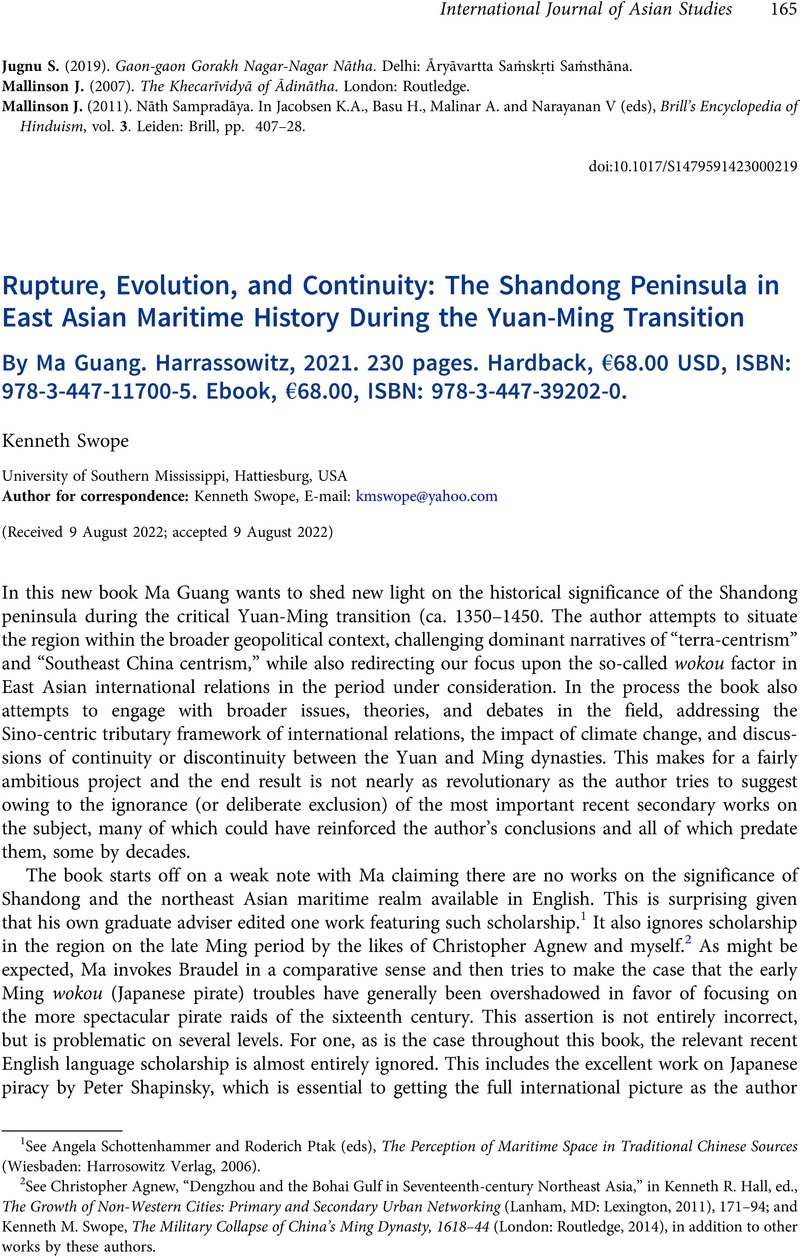No CrossRef data available.
Article contents
Rupture, Evolution, and Continuity: The Shandong Peninsula in East Asian Maritime History During the Yuan-Ming Transition By Ma Guang. Harrassowitz, 2021. 230 pages. Hardback, €68.00 USD, ISBN: 978-3-447-11700-5. Ebook, €68.00, ISBN: 978-3-447-39202-0.
Review products
Published online by Cambridge University Press: 07 September 2022
Abstract

- Type
- Book Review
- Information
- Copyright
- Copyright © The Author(s), 2022. Published by Cambridge University Press
References
1 See Schottenhammer, Angela and Ptak, Roderich (eds), The Perception of Maritime Space in Traditional Chinese Sources (Wiesbaden: Harrosowitz Verlag, 2006)Google Scholar.
2 See Agnew, Christopher, “Dengzhou and the Bohai Gulf in Seventeenth-century Northeast Asia,” in Hall, Kenneth R., ed., The Growth of Non-Western Cities: Primary and Secondary Urban Networking (Lanham, MD: Lexington, 2011), 171–94Google Scholar; and Swope, Kenneth M., The Military Collapse of China's Ming Dynasty, 1618–44 (London: Routledge, 2014)Google Scholar, in addition to other works by these authors.
3 See Shapinsky, Peter, Lords of the Sea: Pirates, Violence, and Commerce in Late Medieval Japan (Ann Arbor: University of Michigan, 2014)Google Scholar.
4 Swope, Kenneth M., “Deceit, Disguise, and Dependence: China, Japan, and the Future of the Tributary System, 1592–1596.” The International History Review 24:4 (2002), pp. 757–82Google Scholar. For more recent scholarship from a political science perspective, see Lee, Ji-Young, China's Hegemony: Four Hundred Years of East Asian Domination (New York: Columbia University Press, 2017)Google Scholar.
5 See Robinson, Kenneth R., “Centering the King of Choson: Aspects of Korean Maritime Diplomacy, 1392–1592.” Journal of Asian Studies 59:1 (2000), pp. 109–25CrossRefGoogle Scholar; and Kang, David, East Asia before the West: Five Centuries of Trade and Tribute (New York: Columbia University Press, 2010)Google Scholar. These are just two examples; there are many more.
6 The most recent such work is Robinson, David M., Korea and the Fall of the Mongol Empire: Alliance, Upheaval and the Rise of a New East Asian Order, new edition (Cambridge: Cambridge University Press, 2022)Google Scholar. Also see Robinson, David M., Empire's Twilight: Northeast Asia Under the Mongols (Cambridge, MA: Harvard University Press, 2009)Google Scholar.





